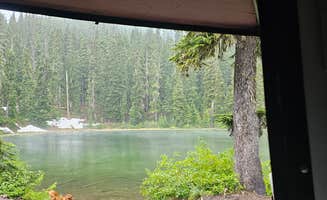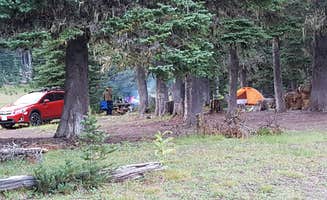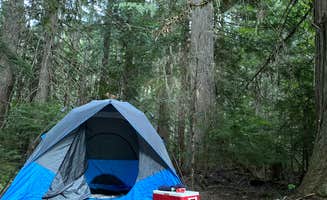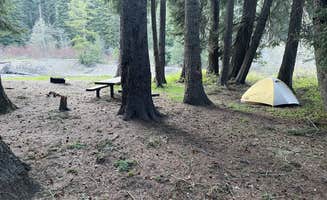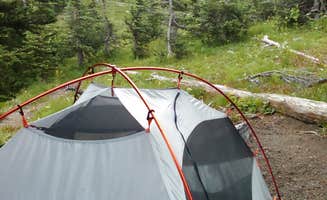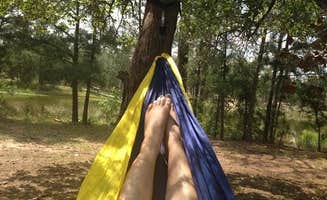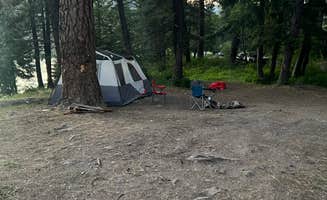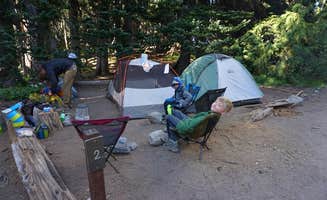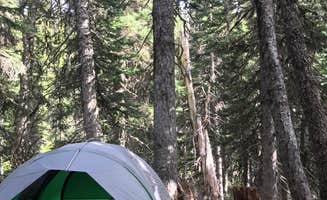Dispersed camping areas near Goose Prairie, Washington provide overnight accommodations within Snoqualmie National Forest and adjacent lands bordering Mount Rainier National Park. Sites range from 2,400 to 4,800 feet in elevation with summer temperatures typically reaching 75-85°F during daytime but dropping to 40-50°F at night. Several popular tent camping spots in the Goose Prairie region remain accessible from late spring through early fall, with nearby creeks and streams providing natural water sources that require treatment before consumption.
What to do
Fishing at Clear Lake Campgrounds: Anglers can fish for trout at Clear Lake North Campground from May through September. Campers note the excellent water access from sites: "Our site was right next to the river... tucked in right next to the river and the bathroom" according to one visitor at Clear Lake North Campground.
Backcountry hiking at Sunrise: Tent campers at the Sunrise Camp Primitive can access the Wonderland Trail just one mile from camp. A visitor described it as "a great base camp for the Burroughs, or a stopping over point in the Wonderland or many other great trails." The campground includes community bear boxes and an outhouse.
Swimming in alpine lakes: From mid-July through August, tent campers can swim in Granite Lake. A visitor described the water as "pretty cold and crystal clear" in early June. The lake offers "a little boat push off or if you wanted to walk in and swim" spots along the shoreline.
What campers like
Privacy between sites: At White River Dispersed Camping, campers appreciate the secluded spots away from the river. One camper found "a large secluded spot in the woods" by driving "a little further in" past the riverside spots that "looked kind of close together."
Mountain wildlife viewing: Tent campers at Summerland Backcountry Campsites observe abundant wildlife. One visitor reported, "Lots of marmots, including in the camping areas. Seemed more interested in munching on lupines than bothering us." The site offers "5G cell service" despite its remote setting.
Lakefront access: Tieton Pond provides undeveloped tent camping directly beside a stocked fishing lake. A visitor notes, "The lake is stocked and the fishing can be quite good early in the season" but warns that "mosquitoes can be a problem later in the season."
What you should know
Road conditions require preparation: Many dispersed tent camping areas demand high-clearance vehicles. For Granite Lake Dispersed Camping Area, a camper warns: "It will require a 4x4, especially after rains, as it's a climb the entire way up over some decent rock gardens." Spring visitors should "bring a chain saw with you as the parks department cleared some previously, I still had to cut 2 more trees."
Limited site availability: Popular campgrounds fill quickly, especially on weekends. Tieton Pond has "very few available spots so it fills up very quickly on weekends." At Granite Lake, campers should have backup plans since "it's a long road back out if the campground is full."
Weather preparedness essential: Temperatures at higher elevation sites drop significantly at night. At Granite Lake, one camper experienced "low 30 temps and a winter mix falling from the sky" in mid-June. Mount Rainier camping can be particularly unpredictable as "Mount Rainier likes to create its own weather."
Tips for camping with families
Choose riverside sites for entertainment: Families report White River Dispersed Camping offers natural playscapes. A camper discovered "a spot tucked super far in that had a small private beach" that was "farther from the road so you couldn't see or hear anything."
Pack for temperature swings: Even in summer, families should bring warm layers for nighttime at Summerland Backcountry Campsites. The campground offers "a fully enclosed privy" that makes overnight stays more comfortable for children, while providing spectacular views of "sunset behind Rainier at a flower adorned stream flowing through a subalpine meadow."
Monitor campground conditions: Some established campgrounds face closure issues. At Clear Lake North, campers should check current status as "signage indicated that the forest service is considering closing this campground" due to improper waste disposal, though the "vault toilets were very well cared for."
Tips from RVers
Small trailer limitations: Most dispersed tent camping areas near Goose Prairie cannot accommodate large RVs. At Corral Pass Campground, a visitor advised: "I would never attempt with a trailer or even cab over camper. We took the tent and my Subaru Crosstrek up, took it slow and did just fine."
Consider weekday visits: RV and trailer campers report dramatically different experiences based on timing. At Clear Lake Campgrounds, "If you come during the week, you're going to enjoy quiet, gorgeous dispersed camping. Big spaces, big trees, big lake. But if you come during the weekend, be prepared for the most inconsiderate, noisy, rude neighbors."
Pack out all waste: The longevity of dispersed camping areas depends on proper waste management. Clear Lake visitors noted they "spent time cleaning up trash and burying toilet paper flowers" due to other campers' negligence, warning that continued problems may lead to site closure.


